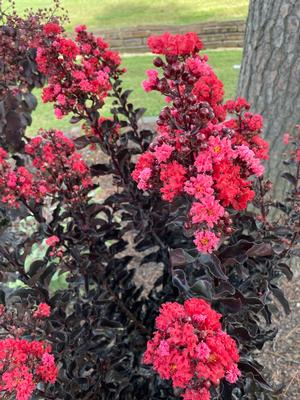Thunderstruck™ Rumblin' Red™ Crapemyrtle
Lagerstroemia x 'JM2' PP31429
Masses of ruby-red flowers bloom on near-black, ruffled foliage in summer through fall. This Crapemyrtle matures lighting-fast at 12 to 15 feet tall and 8 to 10 feet wide. Flashy blooms and foliage create a Perfect Storm in the landscape.
|
Exposure:
Sun
|
Height:
12-15 ft
|
Spread:
8-12 ft
|
USDA Zone:
6
|
|
Key Features:
|
Growth Rate:
|
Flower Color:
|
Blooms:
|
||||||||||||
|
Foliage Color:
|
Interest:
|
Uses:
|
For new plantings
1. Dig a hole one and a half times wider than the plant's container
2. Place plant in hole, keeping the top of the root ball ground level
3. Back fill with dirt
4. Water thoroughly and then mulch around the base to conserve moisture and reduce weeds
New plantings require more frequent watering than established plants. Wind, temperature and soil are factors to consider in watering.
Feed plants in early spring and again in early fall with an all-purpose fertilizer, following label instructions.
5. If crapemyrtle is purchased with a stake, leave it secured to the trunk until the fall or until the stems feel substantial, strong, and well established.
Care Instructions
Crapemyrtles are low-maintenance trees that require little care once established. Water deeply but infrequently to encourage deep root growth. Fertilize once in the spring with a slow-release fertilizer. Mulch around the base of the tree to retain moisture and protect the roots from extreme temperatures. Prune in the late winter or early spring before new growth appears to shape the tree and remove dead or diseased branches. Avoid excessive pruning as it can reduce the number of blooms. Watch for common pests such as aphids and spider mites and treat accordingly.
To prune a crapemyrtle, start by cutting off any dead or damaged branches. Next, remove any branches that are crossing or rubbing against each other. Trim back any branches that are growing toward the center of the tree to promote healthy growth and air circulation. Finally, cut back the top of the tree to the desired height, making sure to leave at least two or three buds on each branch. Avoid "topping" or severe pruning, as this can harm the tree's long-term health and appearance.


